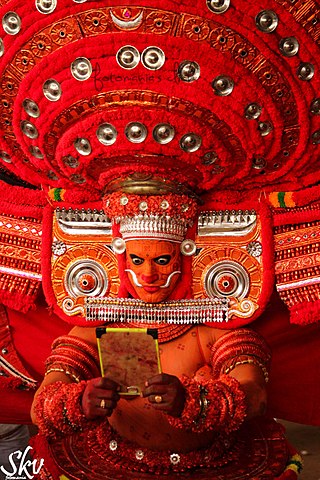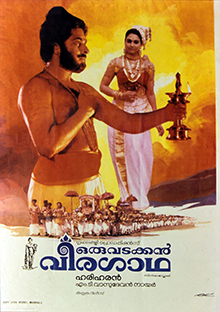Related Research Articles

Kalaripayattu is an Indian martial art that originated in Kerala, a state on the southwestern coast of India during the 11th–12th century CE.

Theyyam is a Hindu religious ritual practiced in northern Kerala and some parts of Karnataka. Theyyam is also known as Kaḷiyāṭṭaṁ or Tiṟa. Theyyam consists of traditions, rituals and customs associated with temples and sacred groves of Malabar. The people of the region consider Theyyam itself as a channel to a god and they thus seek blessings from Theyyam.
A kalari is a gymnasium or training space primarily associated with the martial art of Kalaripayattu. The word kalari comes from Malayalam. In the past, village schools in Kerala, typically run by the traditional astrologer families, were known by the name kalari or Ezhuthu Kalari.
Venad was a medieval kingdom lying between the Western Ghat mountains and the Arabian Sea on the south-western tip of India with its headquarters at the port city of Kollam/Quilon. It was one of the major principalities of Kerala, along with kingdoms of Kannur (Kolathunadu), Kozhikode (Nediyiruppu), and Kochi (Perumpadappu) in medieval and early modern period.
The term Kerala was first epigraphically recorded as Cheras (Keralaputra) in a 3rd-century BCE rock inscription by the Mauryan emperor Ashoka of Magadha. It was mentioned as one of four independent kingdoms in southern India during Ashoka's time, the others being the Cholas, Pandyas and Satyaputras. The Cheras transformed Kerala into an international trade centre by establishing trade relations across the Arabian Sea with all major Mediterranean and Red Sea ports as well those of Eastern Africa and the Far East. The dominion of Cheras was located in one of the key routes of the ancient Indian Ocean trade. The early Cheras collapsed after repeated attacks from the neighboring Cholas and Rashtrakutas.

Oru Vadakkan Veeragatha is a 1989 Indian Malayalam-language epic historical drama film directed by Hariharan, written by M. T. Vasudevan Nair, and starring Mammootty, Suresh Gopi, Balan K. Nair, Captain Raju and Madhavi. The film won four National Film Awards (1989) including Best Actor (Mammootty), Best Screenplay, Best Production Design and Best Costume Design and eight Kerala State Film Awards.

Mushika dynasty, also spelled Mushaka, was a minor dynastic power that held sway over the region in and around Mount Ezhi (Ezhimala) in present-day North Malabar, Kerala, India. The country of the Mushikas, ruled by an ancient lineage of the Hehaya clan of the same name, appears in early historic (pre-Pallava) south India and it is believed that Mushika dynasty has their descents from Heheya Kingdom. Early Tamil poems contain several references to the exploits of Nannan of Ezhimalai. Nannan was known as a great enemy of the pre-Pallava Chera chieftains. The clan also had matrimonial alliances with the Chera, Pandya and Chola chieftains. The Kolathunadu (Kannur) Kingdom, which was the descendant of Mushika dynasty, at the peak of its power, reportedly extended from Netravati River (Mangalore) in the north to Korapuzha (Kozhikode) in the south with Arabian Sea on the west and Kodagu hills on the eastern boundary, also including the isolated islands of Lakshadweep in the Arabian Sea.
Panicker was an honorary title conferred by the King of Travancore in Kerala to distinguished Hindu individuals. This title was given to prominent Nair warriors who led soldiers in battle. It was also sometimes used by Syriac Orthodox Christians, Kaniyar, Ezhava,

The Ezhavas are a community with origins in the region of India presently known as Kerala, where in the 2010s they constituted about 23% of the population and were reported to be the largest Hindu community. The Malabar Ezhava group have claimed a higher ranking in the Hindu caste system than do the others, although from the perspective of the colonial and subsequent administrations they were treated as being of similar rank.

Unniyarcha (ഉണ്ണിയാർച്ച) is a legendary warrior and heroine from the 16th century, mentioned in the Vadakkan Pattukal, a set of historical ballads from northern Kerala, a state in southwestern India. She was a member of a Thiyyar community family called Puthooram Veed in Kadathanad. Her father's name was Kannappa Chekavar. She is believed to have lived in the northern part of Kerala during the 16th century. She is a popular character in Kerala's folklore and is remembered for her valour and skills in Kerala's native martial art, Kalaripayattu. According to legend, Unniyarcha was mostly known for her deadly skill with the whip-like urumi, a unique type of sword that originates from Kerala. Like most traditional Kalaripayattu practitioners, she began training at the kalari at the age of seven.
Vadakkan Pattukal are a collection of Malayalam ballads from the medieval period.

Itty Achudan , was an Indian Herbalist, Botanist and Physician. He belonged to an Ezhava family in Kerala who practised pre-Ayurvedic systems of traditional medicine. The Kollatt family are natives of Kadakkarappally, a coastal village, north-west of Cherthala town, in Kerala, South India. Itty Achudan was the most remarkable Indian figure associated with Hortus Malabaricus, the botanical treatise on the medicinal properties of flora in Malabar, in the 17th-century. It was compiled by the Dutch Governor of Malabar, Hendrik van Rheede, and Itty Achudan was Van Rheede's key informant who disclosed the pre-Ayurvedic traditional knowledge about the plants of Malabar to him. Hortus Malabaricus was published posthumously in Amsterdam between 1678 and 1693. The preface to Hortus Malabaricus includes a mentioning about Itty Achudan and a testimony revealing his contribution in his own hand writing. Itty Achudan was introduced to Van Rheede by Veera Kerala Varma, the then ruler of the erstwhile state of Kochi.

North Malabar refers to the geographic area of southwest India covering the state of Kerala's present day Kasaragod, Kannur, and Wayanad districts, and the taluks of Vatakara and Koyilandy in the Kozhikode District of Kerala and the entire Mahé Sub-Division of the Union Territory of Puducherry. Traditionally North Malabar has been defined as the northern portion of the erstwhile Malabar District which lies between Chandragiri River and Korapuzha River. The region between Netravathi River and Chandragiri River, which included the portions between Mangalore and Kasaragod, are also often included in the term North Malabar, as the Kumbla dynasty in the southernmost region of Tulu Nadu, had a mixed lineage of Malayali Nairs and Tuluva Brahmins.
Thacholi Chandu was a warrior and a legendary hero who is believed to have lived during 17 th century in North Malabar region of Kerala, India. He belonged to the Thacholi family of Nair community. Chandu was married to Thayattu Madathu Mattu Kutti. He is praised about in Vadakkan Pattukal. He is the nephew of legendary Thacholi Othenan.
Kalari Panicker / Kalari Kurup is an ethnic group belonging to the Hindu religion, who live in the South Malabar and central parts of the Indian state of Kerala. They were known as the masters of Kalari tradition, having their Nalpatheeradi Kalari. They are the people who propagated and practiced Kalaripayattu, the martial art form of Kerala.
Aromal Chekavar, also known as Puthooram Veettil Aromal Chekavar, was a warrior who is believed to have lived during the 16th century in the North Malabar region of present-day Kerala, India. He was a warrior from a Thiyyar community and a paramount chief of the Puthooram family. His sister, Unniyarcha, was also a skilled warrior.

Veeram (transl. Valour) is a 2016 Indian historical drama film written and directed by Jayaraj. It is an adaptation of William Shakespeare's Macbeth, and is the fifth installment in Jayaraj's Navarasa series. The film, which also takes inspirations from the Vadakkan Pattukal of North Malabar region in Kerala tells the story of Chandu Chekavar, an infamous warrior in the 13th century North Malabar.
Kottackkal Kanaran Gurukkal (1850–1941), was a Kalaripayattu gurukkal, who contributed to the revival or Kalarippayattu from after British rule. The Kanaran Gurukkal were born in a Chekavar Tharavad, a large Landlord near Vadakara, Kozhikode. He belongs to a Thiyya caste.
References
- ↑ P., Girija, K (2021). Mapping the History of Ayurveda : Culture, Hegemony and the Rhetoric of Diversity. ISBN 978-1-000-48139-6.
{{cite book}}: CS1 maint: multiple names: authors list (link) - 1 2 Menon, A. Sreedhara (4 March 2011). Kerala History and its Makers. D C Books. pp. 82–86. ISBN 978-81-264-3782-5 . Retrieved 10 October 2021.
- ↑ Kurup, K. K. N. (1985). "History of the Tellicherry Factory, 1683-1794".
- ↑ Ullekh.N.p (2018). Kannur:inside India's Bloodiest. Penguin Random House India Private Limited, 2018. p. 201. ISBN 9789353051051.
- 1 2 Nisha, P. R. (12 June 2020). Jumbos and Jumping Devils: A Social History of Indian Circus. ISBN 9780190992071.
- ↑ "Seventh sense: Night Shyamalan is from Africa | Chennai News - Times of India". The Times of India . 15 January 2012.
- ↑ Vishnumangalm Kumar, "Kuroolli Chekon: Charithram Thamaskaricha Kadathanadan Simham" (Keralasabdam, 2007-9-2),Page 30-33, ISBN 96220924
- ↑ "Theyyaprapancham".
- ↑ Mathew, George (1989). Communal Road to a Secular Kerala. Concept Pub.Co, 1989. p. 30. ISBN 81-7022-282-6.
- ↑ Smith, Bardwell L. (1976). Religion and Social Conflict in South Asia. BRILL. p. 27. ISBN 90-04-04510-4.
- ↑ James John (2020). The Portuguese and the Socio-Cultural Changes in Kerala: 1498-1663. Routledge. ISBN 9781000078718.
- ↑ Binu John Mailaparambil (2011). Lords of the Sea: The Ali Rajas of Cannanore and the Political Economy of Malabar. Brill. p. 36. ISBN 9789004180215.
- ↑ Zahira, M. (2014). "Folk performances: Reading the cultural history of the Thiyya community in Kerala". Research in Drama Education: The Journal of Applied Theatre and Performance. 19 (2): 159–164. doi:10.1080/13569783.2014.895619. S2CID 191468000.
- ↑ Jenniffer G.Wollok (2011). Rethinking Chivalry and Courtly Love. ABC publishing. p. 250. ISBN 9780275984885.
- ↑ Folk-Lore (1975). Folk-Lore. p. 96.
- ↑ Heniger, J. (2017). Hendrik Adriaan van Reed Tot Drakestein 1636-1691 and Hortus, Malabaricus. ISBN 9781351441070.
- ↑ Indudhara Menon (2018). Hereditary Physicians of Kerala: Traditional Medicine and Ayurveda in Modern India. Taylor & Francis, 2018. ISBN 9780429663123.
- ↑ David Levinson, Karen Christensen (1996). Encyclopedia of World sport:from Ancient times to the present vol.3. ABC. p. 615. ISBN 9780874368192.